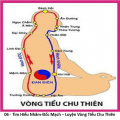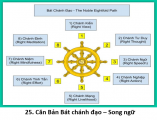The Mind and Reality
Tâm Và Thực Tại
English: Ajahn Brahm
Việt ngữ: Chơn Quán Trần-ngọc Lợi
Compile: Lotus group
40. Tâm Và Thực Tại – The Mind and Reality - Song ngữ

Chương 8: Tâm Và Thực Tại – The Mind and Reality
69. The exorcist - Thầy phù thủy

… she was screaming obscenities
The following is a true story of the supernatural in Thailand, of the supernatural wisdom of the amazing Ajahn Chah.
Chuyện kể dưới đây là một sự thật về trí tuệ siêu việt của Ajahn Chah:
The headman of a nearby village, with one of his assist-ants, walked in hurriedly to see Ajahn Chah under his hut, where he received guests. One of the village women had become possessed by a violent and evil spirit the previous evening. They could not help her, so they were bringing her to the great monk. As they spoke with Ajahn Chah, screaming could be heard not far away.
Ông cả của một làng nọ cùng với vị phụ tá hớt hơ hớt hải chạy đến liêu Ajahn Chah để thỉnh ý Thầy. Số là trong làng nọ có một phụ nữ bị ma hành quỷ ám rất nặng từ đêm hôm qua. Họ xin đưa bà đến để nhờ thầy chữa trị. Bà đang la hét và tiếng bà nghe oang oác khắp xóm.
Ajahn Chah immediately ordered two novices to start a fire and boil up some water; then he told two other novices to dig a big hole close to his hut. None of the novices knew why.
Ajahn Chah gọi bốn chú tiểu, bảo hai chú đi nấu một chảo nước sôi còn hai chú kia đi đào một cái hố gần liêu của thầy. Không ai biết thầy định làm gì!
Four strong village men, tough northeastern rice-farmers, were hardly able to contain the writhing woman. As they dragged her through one of the holiest of monasteries; she was screaming obscenities.
Bấy giờ bà được đưa vào tự viện. Bà tiếp tục chửi bới thô tục bất kể chốn tôn nghiêm và giãy giụa như con cọp sa bẫy phải cần tới bốn nông dân lực lưỡng mới kiềm giữ bà được.
Ajahn Chah saw her and barked at the novices: ‘Dig faster! Get that water boiling! We’ll need a big hole and lots of boiling water.’ Not even the monks and villagers under Ajahn Chah’s hut could figure out what he was up to.
Thấy bà, Ajahn Chah bảo các chú tiểu đào hố và nấu nước sôi nhanh lên. Lời hối thúc của thầy làm các sư trong tự viện và nông dân đi theo bà quýnh lên và không biết chuyện gì sẽ xảy ra.
As they pulled the screaming woman under Ajahn Chah’s hut she was literally foaming at the mouth. Her blood-red eyes were stretched wide with her madness. And her face assumed crazy contortions as she hurled crudity after obscenity at Ajahn Chah. More men joined in to hold down the spitting woman.
Lúc họ đưa bà vô cốc của Ajahn Chah, bà đã sùi bọt mép, mắt bà đỏ ngầu và nhìn trừng trừng, mặt bà nhăn nhó dị thường và miệng bà không ngớt rủa sả Ajahn Chah. Bà điên rồi! Phải thêm nhiều người nữa tiếp tay mới giữ được bà.
‘Is the hole dug yet? Quick! Is the water boiled? Faster!’ Ajahn Chah shouted above the yells of the woman. ‘We have to throw her in the hole. Pour the boiling water all over her. Then bury her. That’s the only way to get rid of this evil spirit. Dig Faster! More boiling water!’
“Hố đào xong chưa? Nhanh lên! Nước sôi chưa? Chụm thêm củi, mau lên!” Ajahn Chah gọi lớn át tiếng của bà điên. Rồi Ngài la lớn, “Phải thảy bà xuống hố, đổ nước sôi lên bà và chôn bà. Chỉ có cách này mới trừ được tà ma đang quấy phá bà mà thôi. Hãy nhanh lên, nhanh lên!”
We had learned from experience that no one could be sure what Ajahn Chah might do. He was uncertainty in the form of a monk. The villagers certainly thought he was about to throw the possessed woman into the hole, scald her all over with boiling water and bury her. And they would let him. She must have thought so too, because she started to grow calm. Before the hole was completed, and before the water was boiled, she was sitting calmly in the peace of exhaustion in front of Ajahn Chah, gracefully receiving a blessing before they gently led her home. Brilliant.
Kinh nghiệm cho biết không ai có thể đoán được ý định của Ajahn Chah. Ngài là một nhà sư rất lạ đời. Các nông dân đinh ninh Ngài sẽ làm như Ngài nói. Bà điên cũng nghĩ vậy nên bắt đầu có dấu hiệu bớt bạo động. Bà ngồi xuống, im lặng và mệt nhừ. Ajahn Chah ra dấu như làm phép cho bà. Và bà được đưa về, hết bệnh. Hay tuyệt!
Ajahn Chah knew that, possessed or just crazy, there is something powerful inside each one of us called self-preservation. He skilfully, and very dramatically, pressed that button in her, and let the fear of pain and death exorcise the demon possessing her.
That’s wisdom: intuitive, unplanned, unrepeatable.
Ajahn Chah cho biết dầu có bị tà ma nhập hay điên điên khùng khùng gì, con người lúc nào cũng sẵn có bản năng tự vệ trong nội tâm. Ngài đã khéo léo khai thác điểm này: Ngài để sự sợ hãi cái đau đớn (vì nước sôi) và cái chết (bị chôn sống) đánh đuổi các tà ma (hay sự điên khùng cũng thế) ra khỏi bà.
Đó là trí tuệ: trực giác, không thể đoán trước và không lặp lại hai lần.
70. The biggest thing in the world - Cái lớn nhất thế gian

… but your mind that is the biggest thing in the world.
The daughter of a friend from my college days was in her first year at primary school. Her teacher asked the large class of five-year-old, ‘What is the biggest thing in the world?’
Đứa con gái của một bạn học cũ vừa đủ năm tuổi và vào lớp 1. Thầy giáo của lớp cháu hỏi các học trò tí hon của mình, “Cái gì lớn nhất trên thế gian này?” Một bé nhanh nhẩu đáp:
My daddy,’ said one small girl. ‘An elephant,’ answered a young boy who had recently been to the zoo.
‘A mountain,’ replied another.
My friend’s young child said, ‘My eye is the biggest thing in the world.’
“Ba con.”
“Coi voi,” là câu trả lời của một bé trai mới đi sở thú hồi cuối tuần.
“Núi.”
“Mắt con lớn nhất thế gian”, cháu gái của bạn tôi nói.
The class went quiet as they all tried to understand the little girl’s answer. ‘What do you mean?’ asked her teacher, equally perplexed.
‘Well,’ began the miniature philosopher, ‘My eye can see her daddy, and it can see an elephant. It can also see a mountain and many other things as well. Since all this can fit into my eye, my eye must be the biggest thing in the world!’
Cả lớp im lặng suy nghĩ câu trả lời vừa rồi. Cả thầy giáo cũng phải nhíu mày, thầy hỏi, “Tại sao con nghĩ như vậy?”
Nhà triết học tí hon của chúng ta chậm rãi giải thích:
“Thưa thầy, mắt con có thể thấy ba của bạn con, thấy con voi, thấy trái núi và các thứ khác. Vì mắt con có thể chứa đựng tất cả, mắt con lớn nhất thế giới.”
Wisdom is not learning, but seeing clearly what can never be taught.
With much respect to my friend’s young daughter, I would extend her insight a little further. It is not your eye but your mind that is the biggest thing in the world.
Trí tuệ không thể học mà có; trí tuệ thấy được rõ ràng cái không thể dạy.
Tôi khâm phục cháu bé, con của bạn tôi. Tôi chỉ xin nói thêm rằng không phải mắt mà tâm là vật lớn nhất trên đời.
Your mind can see all that your eye can see, and it can see more that is supplied through your imagination. It can also know sounds, which your eye can never see, and know touch, both real and made of dream stuff. Your mind can also know what lies outside your five senses. Because everything that can be known can fit into your mind, your mind must be the biggest thing in the world. The mind contains all.
Tâm nhìn thấy được tất cả những gì mắt thấy và cả những gì do tưởng tượng cung cấp. Tâm còn biết được âm thanh và xúc giác mà mắt không thấy. Tâm biết luôn thế giới ngoài năm giác quan. Lý luận như cháu bé nói trên, tâm chứa tất cả nên tâm lớn nhất thế gian này vậy.
71. Searching for the mind - Tâm ở đâu?

The mind is the biggest thing …, it contains the universe.
Many scientists and their supporters assert that the mind is merely a by-product of the brain, so in question time after my talks I am often asked: ‘Does the mind exist? If so, where? Is it in the body? Or is it outside? Or is it everywhere and all over? Where is the mind?’
Nhiều bác học và học trò của các ông khẳng định rằng tâm chỉ đơn thuần là một phụ phẩm của bộ óc. Tôi thường được thính chúng hỏi, “Tâm có thật không? Nếu có thật, tâm ở đâu? Trong hay ngoài thân thể (sắc)? Hay ở cùng khắp mọi nơi?”
To answer this question, I conduct a simple demonstration:
I ask my audience: ‘If you are happy right now, raise your right hand please. If you are unhappy, even a little, please raise your left hand.’ Most people raise their righthand, some truly, the rest out of pride.
‘Now,’ I continue, ‘those who are happy, please point to that happiness with your right index finger. Those who are unhappy, please point to that unhappiness with your left index finger. Locate it for me.’
My audience begin to wave their fingers pointlessly up and down. Then they glance around at their neighbors in similar confusion. When they get the message, they laugh.
Để trả lời, tôi chỉ dùng thí nghiệm sau:
Tôi đề nghị: “Ai hiện đang vui vẻ, hạnh phúc xin giơ tay mặt lên. Ngược lại xin giơ tay trái vậy.” Hầu hết đưa tay mặt lên - một số thật tình đang vui, số còn lại vì tự ái.
Tiếp theo tôi nói: “Ai đang hạnh phúc, xin dùng ngón tay trỏ mặt chỉ điểm hạnh phúc của mình. Ngược lại, xin dùng ngón tay trỏ trái vậy.”
Thính chúng bắt đầu chỉ lên, chỉ xuống rồi nhìn trái, nhìn phải xem bạn mình làm gì. Họ bối rối thấy rõ. Chừng hiểu ra ai cũng bật cười.
Happiness is real. Unhappiness is true. There is no doubt that these things exist. But you cannot locate these realities anywhere in your body, anywhere outside of your body, or anywhere at all. This is because happiness and unhappiness are part of the territory exclusive to the mind. They belong to the mind, like flowers and weeds belong to the garden. The fact that flowers and weeds exist proves that a garden exists. In just the same way, the fact that happiness and unhappiness exist proves that the mind exists. The discovery that you cannot point to happiness or unhappiness shows that you cannot locate the mind in three-dimensional space. Indeed, remembering that the mind is the biggest thing in the world—the mind cannot be within three-dimensional space, but three-dimensional space is within the mind. The mind is the biggest thing in the world, it contains the universe.
Hạnh phúc cũng như đau khổ có thật, không ai chối cãi. Nhưng không ai biết chúng nằm ở đâu, trong hay ngoài thân thể này. Lý do là vì hạnh phúc hay đau khổ là những đặc trưng của tâm. Chúng thuộc tâm như hoa thơm, cỏ dại thuộc ngôi vườn. Có hoa có cỏ chúng ta mới biết có ngôi vườn. Cũng vậy, có hạnh phúc có đau khổ chúng ta mới biết có tâm. Tâm có thật nhưng không ở trong thế gian ba chiều. Biết rằng tâm lớn nhất thế gian - tâm không thể được thu gọn trong thế giới ba chiều mà ngược lại, thế giới ba chiều nằm trong tâm. Tâm chứa cả vũ trụ.
72. Science - Khoa học
I was a scientist before becoming a monk. I explored the Zen-like world of theoretical physics at Cambridge University in England. Science and religion, I have found, hold many things in common, one of which is dogma. A delightfully descriptive saying I remember from my student days was: ‘The eminence of a great scientist is measured by the length of time he or she obstructs progress in their field!’
Tôi theo khoa học trước khi làm sư. Tôi tốt nghiệp Vật lý lý thuyết tại đại học Cambridge, Anh quốc. Tôi nhận thấy khoa học và tôn giáo có nhiều điểm tương đồng, mà giáo điều là một. Tôi còn nhớ rất rõ ràng câu nói đầy hình ảnh mà tôi nghe được lúc ngồi trên ghế nhà trường: “Danh tiếng của một nhà khoa học lớn được đo bằng thời lượng mà ông hay bà ấy đã cản trở tiến trình của ngành mà ông hay bà ấy đang nghiên cứu.”
At a recent debate in Australia between science and religion, at which I was a speaker, I took a poignant question from a member of the audience: ‘When I look through a telescope at the beauty of the stars,’ said the devout Catholic woman, ‘I always feel that my religion is threatened.’ ‘Madam, when a scientist looks down the other end of a telescope, from the big end to the small end,’ I replied, ‘to gaze upon the one who is looking, then science is threatened!’
Trong một cuộc tranh biện về khoa học và đạo giáo mới đây tại Úc Châu, tôi có nhận được một câu hỏi hóc búa của một thính giả như sau: “Lúc nhìn qua viễn vọng kính thấy sao đẹp trên trời, tôi luôn luôn có cảm tưởng đạo tôi (đạo thiên chúa) đang bị đe dọa.” Tôi đáp rằng: “Thưa bà, khi nhìn ngược ống viễn vọng kính từ đầu lớn ra đầu nhỏ để nhìn người đang nhìn, khoa học bị đe dọa!”
73. The science of silence - Khoa im lặng
“Người biết không nói; người nói không biết”- Lão Tử
Perhaps it is better to stop arguing altogether. A famous Eastern proverb goes: He who knows, doesn’t say; He who says, doesn’t know.
Có lẽ chúng ta nên ngưng sự tranh cãi tại đây là hơn. Ngạn ngữ phương đông có nói, “Người biết không nói; người nói không biết”
This might sound profound until you work out that whoever said it, therefore didn’t know!
Câu nói trên có vẻ uyên thâm cho đến khi bạn tìm ra người nói, thật sự là không biết!
74. Blind faith - Tin tưởng mù quáng
Lithograph of the storming of the Bastille in on July 14, 1789 (adoc-photos/Corbis via Getty Images)
When we get old our eyesight fades, our hearing goes, our hair falls out, our false teeth go in, our legs become weak and our hands sometimes shake. But the one part of our anatomy that seems to get ever stronger with each passing year is our talkative mouth. This is why the most verbose of our citizens may qualify as politicians only in their later years.
Tuổi già đến, mắt phải mờ, tai phải điếc, tóc phải bạc, răng phải long, chân phải yếu và tay phải run; chỉ có miệng là khỏe, càng ngày càng nói nhiều. Đó cũng là lý do tại sao ta thấy chánh khách ngày càng lớn tuổi càng hay nói.
A King many centuries ago had trouble with his ministers. They would argue so much that almost nothing was decided. The ministers, following the most ancient of political traditions, each claimed that they alone were right and every one else was wrong. However, when the resourceful King organized a special public festival, they all agreed to take the day off.
The festival was a spectacular affair held in the large stadium. There was singing and dancing, acrobatics, clowns, music and much else. Then for the finale in front of the huge crowd, with the ministers occupying the best seats of course, the King himself led his royal elephant into the center of the arena. Following the elephant came seven blind men, known in the city to have been blind since birth.
The King took the hand of the first blind man, helped him feel the elephant’s trunk and told him that this is an elephant. He then helped the second blind man feel the elephant’s tusk, the third one its ears, the fourth the head, the fifth the torso, the sixth the legs, and the seventh the tail, telling each one that this was an elephant. Then he returned to the first blindman and asked him to say in a loud voice what an elephant was.
Ngày xưa có một nhà vua không quyết định được việc triều chính vì mỗi năm khi lâm triều bá quan văn võ đua nhau tranh nói và ai cũng bảo mình đúng. Hôm nọ triều đình có tổ chức một lễ hội có đầy đủ trò vui chơi. Nhà vua cho đem vào một con voi và bảy người mù bẩm sinh. Đích thân nhà vua nắm tay mỗi người mù để họ rờ voi, và mỗi người rờ một phần của con voi. Xong, Ngài hỏi cảm tưởng của mỗi người: voi có hình dáng như thế nào?
‘In my considered and expert opinion,’ said the first blindman, feeling the trunk, ‘I state with utmost certainty that an “elephant” is a species of snake, genus Python asiaticus.’
“Theo sự hiểu biết chuyên môn của tôi,” người sờ vòi nói, “Con voi là một con trăn thuộc loài Python asiaticus”
‘What twittering twaddle!’ exclaimed the second blindman, feeling a tusk. ‘An “elephant” is much too solid to be a snake. In actual fact, and I am never wrong, it is a farmer’s plough.’
“Tầm phào!”Người rờ ngà chê và giải thích, “Voi cứng như vậy làm sao là trăn được. Tôi chưa bao giờ nói sai và xin khẳng định nó giống tay cày của nông dân ta.”
‘Don’t be ridiculous!’ jeered the third blind man, feeling an ear. ‘An “elephant” is a palm-leaf fan.’
“Lố bịch,” người rờ tai voi cười khẩy vừa nói, “Giống cái quạt lá cọ.”
‘You incompetent idiots!’ laughed the fourth blind man, feeling the head. ‘An “elephant” is obviously a large water jar.’
“Thiệt là đồ khùng,” người rờ mình cười lớn, đắc ý nói, rõ ràng giống cái thùng bự.”
‘Impossible! Absolutely impossible!’ ranted the fifth blindman, feeling the torso. ‘An “elephant” is a huge rock.’
“Tất cả đều là đồ ngốc,” người rờ đầu huênh hoang nói, “giống một khối đá lớn.”
‘Bulldust!’ shouted the sixth blind man, feeling a leg. ‘An “elephant” is a tree trunk.’
“Khoác lác!” người rờ chân la lớn, “Giống thân cây.”
‘What a bunch of twerps!’ sneered the last blind man, feeling the tail. ‘I’ll tell you what an “elephant” really is. It is a kind of fly whisk. I know, I can feel it!’
“Toàn thứ dốt,” người rờ đuôi bĩu môi nói, “Nghe tôi đây nè, nó giống cây phất trần. Tôi đã rờ và biết chắc như vậy”
‘Rubbish! It’s a snake.’ ‘Can’t be! It’s a jar.’ ‘No way! It’s a...’ And the blind men started arguing so heatedly, and all at same time, that the words melted together in one loud and long yell. As the insults flew, so did the fists. Though the blind men weren’t quite sure who they were hitting, it didn’t seem that important in the fury of the fracas. They were fighting for principle, for integrity, for truth. Their own individual truth, that was.
While the King’s soldiers were separating the blind and bruised brawlers, the crowd in the stadium was mocking the silent, shamefaced ministers. Everyone who was there had well understood the point of the King’s object lesson. (10)
Bảy người mù rờ voi bắt đầu cãi vã, rồi chửi bới và sau cùng đi đến ẩu đả. Họ chửi nhau vì tự tin - tin mình trúng và vì sự thật - sự thật của riêng mình.
Trong lúc quân ngự lâm ngăn can đám mù, các đại quan cảm thấy nhục nhã và cúi đầu. Mọi người có mặt đều hiểu ẩn ý của “tấm hài kịch” và không quên chế nhạo các đại thần. (viết theo Kinh Phật Tự Thuyết, Udana, chương 6, số 4)
Each one of us can know only a part of the whole that constitutes truth. When we hold on to our limited knowledge as absolute truth, we are like one of the blind men feeling a part of the elephant and inferring that their own partial experience is the truth, all else being wrong.
Mỗi người chúng ta chỉ biết được một góc nhỏ của sự thật. Nếu căn cứ vào góc nhỏ ấy để nói rằng đó là sự thật, chúng ta không khác nào như người mù rờ voi.
Instead of blind faith, we can have dialogue. Imagine the result if the seven blind men, instead of opposing their data, had combined their experience. They would have concluded that an ‘elephant’ is something like a huge rock standing on four stout tree trunks. On the back of the rock is a fly whisk, on the front a large water jar. At the sides of the jar are two palm-leaf fans, with two ploughs towards the bottom and along python in the middle! That would not be such a bad description of an elephant, for one who will never see one.
Thay vì tự tin mù quáng, chúng ta nên chia sẻ. Ẩn dụ trên cho thấy nếu bảy người mù chia sẻ kinh nghiệm mình, họ có thể đi đến kết luận là con voi giống như một cái thùng rất to đặt trên bốn gốc cây lớn với cây phất trần gắn phía sau và một tảng đá ở phía trước. Tảng đá có con trăn dài quấn tòn ten đằng đầu, hai cây quạt lá cọ phất phất hai bên hông và hai cán cày đâm xuống đất. Mô hình này không đến nỗi tệ, ít ra cũng giúp cho người chưa bao giờ thấy con voi có khái niệm về con voi như thế nào.
Sources:
Tài liệu tham khảo:
- https://tienvnguyen.net/p147a885/chuong-8-
- https://www.bps.lk/olib/bp/bp619s_Brahm_Opening-The-Doors-Of-Your-Heart.pdf
- Photo 2: https://www.askideas.com/50-very-funny-horse-face-pictures-and-images/
- Photo 3: http://evdhamma.org/index.php/documents/buddhist-meditation/item/72-chin-tang-tam-thuc-song-ngu
- Photo 4: https://quotefancy.com/quote/1705982/Buddha-The-mind-contains-all-possibilities
- Photo 5: https://twitter.com/chuckcanady/status/1033496847434870785
- Photo 6: https://time.com/5673239/left-right-politics-origins/


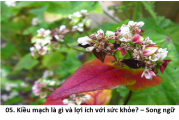
![[7-12] - Chuyện Vui Ngắn - Short Funny Stories – Song ngữ [7-12] - Chuyện Vui Ngắn - Short Funny Stories – Song ngữ](/images/resized/59b514174bffe4ae402b3d63aad79fe0_7-12._title_224_120.png)
![[13-20] - Chuyện Vui Ngắn - Short Funny Stories – Song ngữ [13-20] - Chuyện Vui Ngắn - Short Funny Stories – Song ngữ](/images/resized/fa447a14965dfd70772de1948c4d467d_13-20._title_224_120.png)
